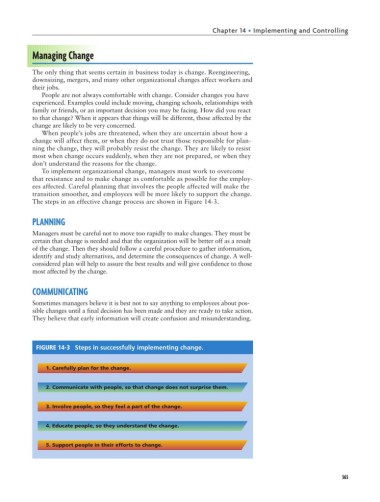Page 376 - Business Principles and Management
P. 376
Chapter 14 • Implementing and Controlling
Managing Change
The only thing that seems certain in business today is change. Reengineering,
downsizing, mergers, and many other organizational changes affect workers and
their jobs.
People are not always comfortable with change. Consider changes you have
experienced. Examples could include moving, changing schools, relationships with
family or friends, or an important decision you may be facing. How did you react
to that change? When it appears that things will be different, those affected by the
change are likely to be very concerned.
When people’s jobs are threatened, when they are uncertain about how a
change will affect them, or when they do not trust those responsible for plan-
ning the change, they will probably resist the change. They are likely to resist
most when change occurs suddenly, when they are not prepared, or when they
don’t understand the reasons for the change.
To implement organizational change, managers must work to overcome
that resistance and to make change as comfortable as possible for the employ-
ees affected. Careful planning that involves the people affected will make the
transition smoother, and employees will be more likely to support the change.
The steps in an effective change process are shown in Figure 14-3.
PLANNING
Managers must be careful not to move too rapidly to make changes. They must be
certain that change is needed and that the organization will be better off as a result
of the change. Then they should follow a careful procedure to gather information,
identify and study alternatives, and determine the consequences of change. A well-
considered plan will help to assure the best results and will give confidence to those
most affected by the change.
COMMUNICATING
Sometimes managers believe it is best not to say anything to employees about pos-
sible changes until a final decision has been made and they are ready to take action.
They believe that early information will create confusion and misunderstanding.
FIGURE 14-3 Steps in successfully implementing change.
1. Carefully plan for the change.
2. Communicate with people, so that change does not surprise them.
3. Involve people, so they feel a part of the change.
4. Educate people, so they understand the change.
5. Support people in their efforts to change.
363

